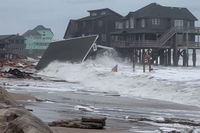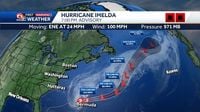Hurricane Imelda, a formidable Category 2 storm, battered Bermuda on October 1, 2025, with heavy winds and relentless rain, forcing the island nation to shut down public life and brace for what officials described as a dangerous and potentially destructive event. The U.S. National Hurricane Center reported that Imelda was packing maximum sustained winds of 100 mph (155 kph) and was moving east-northeast at 24 mph as it closed in on Bermuda, sitting just about 100 miles west-southwest of the island by Wednesday evening.
As the storm approached, Bermuda’s government took swift and decisive action. Public schools, government offices, and the international airport were closed, and 100 soldiers were deployed to secure critical infrastructure, clear roads, and assist at emergency shelters. Michael Weeks, Bermuda’s national security minister, underscored the gravity of the situation, stating, “This is a dangerous storm system that could bring destructive winds, heavy rainfall and significant coastal impacts,” according to the Associated Press.
The National Hurricane Center maintained a hurricane warning for Bermuda, warning residents to expect hurricane-force winds, damaging waves, and flash flooding through the night and into Thursday morning. Tropical storm conditions were already being felt on the island by Wednesday evening, with forecasters predicting that hurricane conditions would intensify as the eye of Imelda passed near or possibly over Bermuda overnight. The strongest winds, experts said, would likely occur early Thursday morning, even after the storm’s center had moved away from the island.
Imelda was forecast to dump between 2 and 4 inches (5 to 10 centimeters) of rain on Bermuda, raising concerns about significant flooding and a dangerous storm surge. By late Wednesday, hundreds of customers across the island were already without power, and emergency crews were on standby to respond to outages and flooding. The storm surge and heavy rainfall were expected to trigger coastal flooding, a risk that loomed large for the island’s vulnerable shorelines.
The impact of Imelda was not limited to Bermuda. Earlier in the week, the hurricane unleashed widespread flooding in eastern Cuba, resulting in two fatalities. In Guantánamo province, more than 18,000 people were evacuated as the storm’s heavy rains inundated communities and damaged infrastructure. As of Wednesday, over 3,500 people remained displaced in Guantánamo, and crews had begun the arduous task of repairing damaged roads and bridges. In Santiago de Cuba, flooding and landslides cut off access to 17 communities, isolating more than 24,000 residents, according to state reports cited by the Associated Press.
Haiti, too, felt the effects of Imelda’s wrath. Authorities there reported that one person was missing and two others had been injured following heavy flooding in the country’s southwest and northwest regions. The storms’ impacts across the northern Caribbean were a stark reminder of the vulnerability of island nations during hurricane season.
Meanwhile, Hurricane Humberto, which had been racing ahead of Imelda, dissipated on Wednesday after passing west of Bermuda on Tuesday. Its remnants were reclassified as Storm Amy by U.K. forecasters, who warned that the system would bring adverse weather to Ireland and the U.K. starting Friday. The National Hurricane Center confirmed that Humberto had merged with a frontal system and was no longer a threat to land, but it would remain a powerful storm over the northern Atlantic.
The combined effects of Imelda and Humberto were felt far and wide. Large swells and dangerous surf generated by both systems impacted beaches along the north Caribbean, the Bahamas, Bermuda, and much of the U.S. East Coast. Deadly rip currents posed a significant risk from Florida all the way north to Maine. In North Carolina’s Outer Banks, at least five unoccupied houses collapsed into the ocean on Tuesday, a stark testament to the relentless power of the waves and the ongoing erosion that has plagued the region in recent years, according to the U.S. National Park Service.
This year’s Atlantic hurricane season has been unusual in several respects. According to AccuWeather, 2025 marked the first time in a decade that no hurricane had made landfall in the United States by the end of September. Only Tropical Storm Chantal had come ashore earlier in the year. Alex DaSilva, AccuWeather’s lead hurricane expert, noted, “This hurricane season so far is quite unique, with several close calls for the United States.” He explained that Humberto had actually pulled Imelda away from the U.S. East Coast through a rare meteorological phenomenon known as the Fujiwhara Effect, in which two storms close together begin to rotate around each other. Humberto and Imelda were just 467 miles apart earlier this week—the closest recorded distance between two Atlantic hurricanes since 1853, according to hurricane specialist Michael Lowry.
The Atlantic hurricane season officially runs from June 1 to November 30, and the U.S. National Oceanic and Atmospheric Administration had predicted an above-normal season, with 13 to 18 named storms expected. Of those, five to nine were forecast to become hurricanes, including two to five major hurricanes with winds of at least 111 mph (178 kph). Imelda became the fourth hurricane of the Atlantic season when it intensified on Tuesday, October 1, 2025.
Despite the season winding down, meteorologists have cautioned that atmospheric conditions remain favorable for tropical storms and hurricanes well into late October and November. “We expect atmospheric conditions that could support tropical storms and hurricanes well into late October and November this year,” DaSilva told the Associated Press, urging residents in hurricane-prone regions to stay alert and prepared.
Locally, in southeast Louisiana, the impacts from Imelda were minimal, with only light showers observed on October 1, 2025. However, forecasters expected increasing rain and thunderstorms later in the week, with rainfall totals of 2.5 to 5 inches predicted mainly offshore, and 1 to 3 inches inland. The Gulf and Caribbean remained quiet, with no new tropical systems expected to develop in the following week, according to the latest advisories.
As Bermuda and its neighbors in the Caribbean and Atlantic continue to recover from Imelda’s onslaught, the storm stands as a sobering reminder of nature’s power and the importance of preparedness in the face of an increasingly unpredictable hurricane season.





